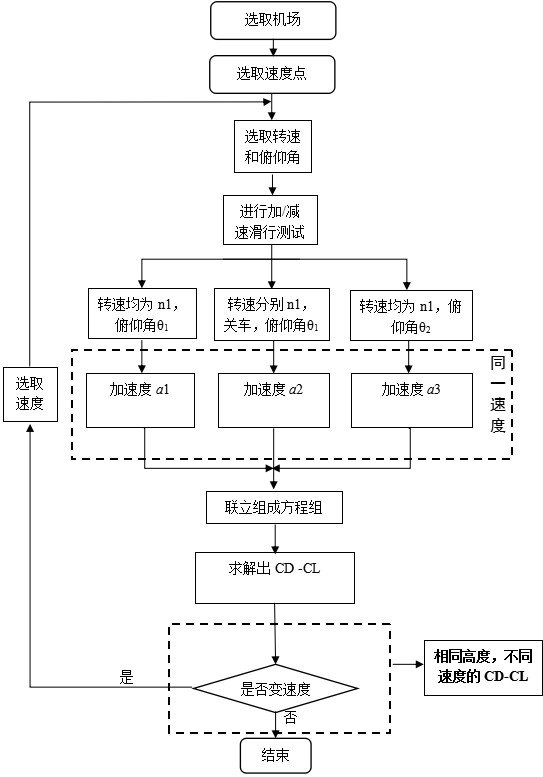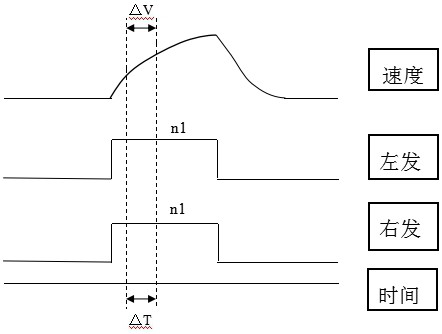A method for identifying the balance pole curve of twin-engine aircraft through ground taxiing test
A technology of ground taxiing and taxiing test, applied in the direction of aircraft component testing, etc., can solve the problems of high risk and high cost of air flight test, and achieve the effect of shortening the cycle, reducing the risk of flight test, and saving costs.
- Summary
- Abstract
- Description
- Claims
- Application Information
AI Technical Summary
Problems solved by technology
Method used
Image
Examples
Embodiment 1
[0076] A method of identifying the balance pole curve of a twin-engine aircraft through ground taxiing tests, ignoring the change in intake distortion caused by engine speed changes; the test runway is horizontal, and the angle of attack and pitch angle are the same; figure 1 As shown in Fig. 1, select two sliding state points with different pitch angles to carry out the sliding tests of synchronous acceleration / deceleration and asynchronous acceleration / deceleration of the two engines at different speeds, respectively, and calculate the acceleration / deceleration through the acceleration / deceleration motion graph; thus The model resistance and lift-induced resistance factors are calculated, such as Figure 9 As shown, the fitted plane balance pole curve CD-CL. In order to facilitate the calculation of the correction amount of the aircraft balance pole curve, two taxiing state points with different pitch angles are selected for testing.
[0077] The invention overcomes the in...
Embodiment 2
[0079] This embodiment is optimized on the basis of embodiment 1, such as figure 1 Shown, the present invention comprises the following steps:
[0080] 1) Select working conditions, namely weight, speed and pitch angle;
[0081] 2) Under two different pitch angles, the sliding tests of the synchronous acceleration / deceleration of the two engines at different speeds and the asynchronous acceleration / deceleration of the two engines are carried out;
[0082] 3) Calculate the acceleration / deceleration in the same speed range during different taxiing processes;
[0083] 4) Through the taxiing process in different states, the drag coefficient, lift-induced drag factor and form resistance are respectively solved, and the aircraft equilibrium pole curve under this working condition (speed point) is identified;
[0084] 5) Change the speed, repeat steps 2) to 4), and identify the balance pole curves of the aircraft at different speeds.
[0085] As shown in Table 1, two state points...
Embodiment 3
[0091] This embodiment is optimized on the basis of embodiment 1 or 2, as figure 2 As shown, the calculation formula of the acceleration / deceleration motion in the sliding test is as follows:
[0092]
[0093] in, L is the lift of the aircraft, N is the supporting force of the aircraft tire, G is the gravity of the aircraft, T is the total thrust of the two engines, D is the drag of the aircraft, f is the friction force on the plane, m for the mass of the aircraft, a is the acceleration / deceleration of the aircraft, ρ is the density, V for speed, S is the reference area, CL is the lift coefficient, cd is the drag coefficient.
[0094] Other parts of this embodiment are the same as those of Embodiment 1 or 2 above, so details are not repeated here.
PUM
 Login to View More
Login to View More Abstract
Description
Claims
Application Information
 Login to View More
Login to View More - R&D
- Intellectual Property
- Life Sciences
- Materials
- Tech Scout
- Unparalleled Data Quality
- Higher Quality Content
- 60% Fewer Hallucinations
Browse by: Latest US Patents, China's latest patents, Technical Efficacy Thesaurus, Application Domain, Technology Topic, Popular Technical Reports.
© 2025 PatSnap. All rights reserved.Legal|Privacy policy|Modern Slavery Act Transparency Statement|Sitemap|About US| Contact US: help@patsnap.com



